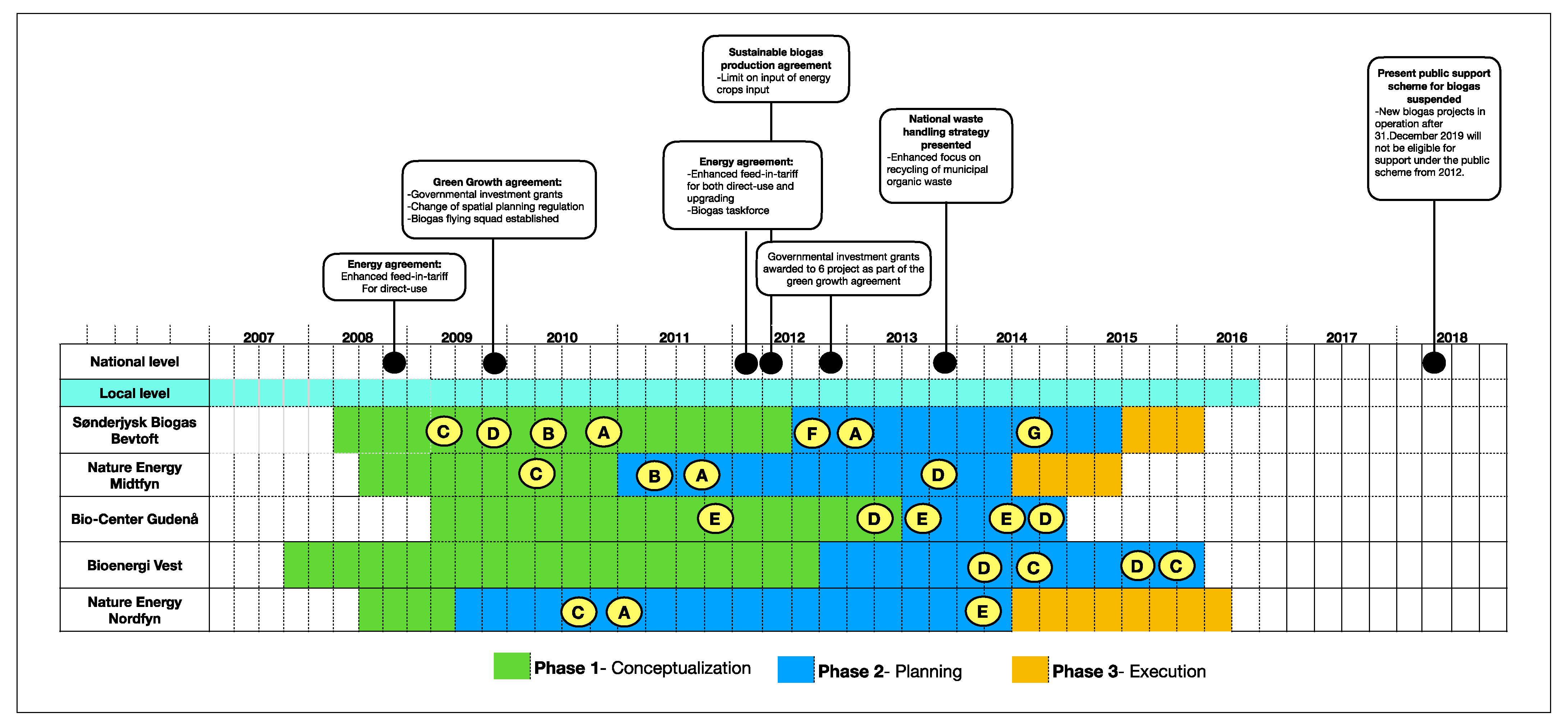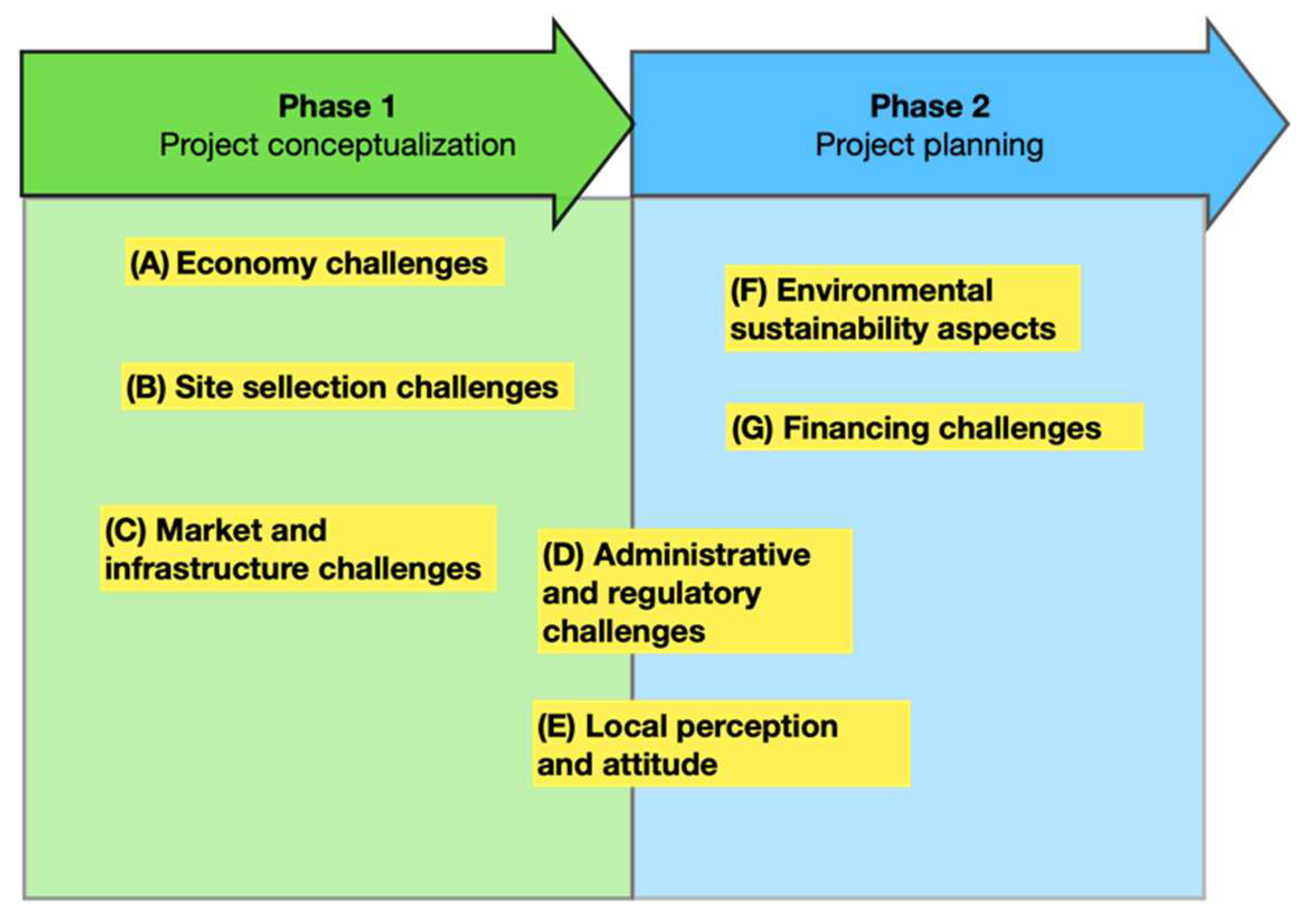Identifying Challenges and Drivers for Deployment of Centralized Biogas Plants in Denmark
Abstract
:1. Introduction
Research Question
2. Materials and Methods
2.1. Analytical Framework
2.1.1. Literature Review of Challenges in the Deployment of Biogas Plants
2.1.2. Analytical Framework for This Article
- Economy challenges (A);
- Site selection challenges (B);
- Market and infrastructure (C);
- Administrative and regulatory challenges (D);
- Local perception and attitude (E);
- Environmental sustainability aspects (F);
- Financial challenges (G).
2.2. Methodology
2.2.1. Multiple Case Studies
2.2.2. Longitudinal Study
2.2.3. Document Collection and Analysis
2.2.4. Semi-Structured Interviews
3. Results
3.1. Case Studies
3.1.1. Case 1: Sønderjysk Biogas Bevtoft
Phase 1—Conceptualization 2008–2011
Phase 2—Planning 2011–2015
Phase 3—Execution 2015–2016
3.1.2. Case 2: Nature Energy Midtfyn (Faaborg-Midtfyn Biogas)
Phase 1—Conceptualization 2008–2010
Phase 2—Planning 2010–2015
Phase 3—Execution 2015–2016
3.1.3. Case 3: Bio-Center Gudenå
Phase 1—Conceptualization 2009–2013
Phase 2—Planning 2013–2014
Epilogue
3.1.4. Case 4: Bioenergi Vest
Phase 1—Conceptualization 2007–2012
Phase 2—Planning 2012–2016
Phase 3—Execution/Epilogue 2016–2017
3.1.5. Case 5: Nature Energy Nordfyn (Nordfyn Biogas)
Phase 1—Conceptualization 2008–2010
Phase 2—Planning 2012–2014
Phase 3—Execution 2014–2016
4. Identified Challenges
4.1. Economic Challenges (A)
4.2. Site Selection Challenges (B)
4.3. Market and Infrastructure Challenges (C)
4.4. Administrative and Regulatory Challenges (D)
4.5. Local Perception and Attitude (E)
4.6. Sustainability and Ecological Aspects (F)
4.7. Financing Challenges (G)
5. Identified Drivers
5.1. National Level
5.1.1. Enhanced Polices
5.1.2. Access to the National Gas Infrastructure
5.1.3. Initiatives Supporting Local Government and Projects Owners
5.1.4. Involvement of Well-Established Energy Companies in the Biogas Sector
5.2. Local Level
5.2.1. Bottom-Up Approach, Vision of Change Agents and Project Management Style
5.2.2. Gaining Trust of Local Communities
5.2.3. Facilitating Role of Municipalities
6. Discussion
- In the Danish case, an enhanced feed-in tariff for both direct use and a governmental investment grant program created the spark among local initiators. Equalization and enhancement of the feed-in tariff for both direct use and upgrading biogas a couple of years after meant that the biogas sector gained access to a new infrastructure, which sparked the interest of well-established energy companies. The combination can thus be recommended. A special incentive should, however, still be put in place for direct use of biogas, which is more energy-efficient than upgrading. In the Danish context, the direct use of biogas for CHP has almost completely been abandoned since 2012. Here, easier access to national guaranteed financing with low interest rates for renewable energy projects is recommendable. Alternatively, they could remove the regulatory limitation on municipality guaranteed loans for renewable energy projects.
- When accelerating the deployment of biogas plants, it would also be a good idea to establish a national legal office that can support project developers and municipalities with interpretation and guidelines related to the sometimes very complex regulation framework surrounding biogas production and coordinate efforts between different governmental branches. This could be supplemented with spatial planning support and project development support like the national biogas flying squad and the Biogas Taskforce provided in Denmark.
- Also, in terms of fast-tracking the regulatory approval of biogas plants, it is recommended to establish educational courses for both local project developers and municipal planners, to create a common understanding of the regulatory requirement that the project is expected to meet, and to ensure that the administration is handled efficiently, without being prolonged. This could help share best practices related to gaining the trust of local communities. Also, it would be a good idea for climate mitigation action to be made a mandatory task for municipalities, as the general advocacy of renewable energy as shown is a key factor in successful deployment.
- Finally, a last recommendation is to enhance research and development into optimizing the operations cost for utilization of deep litter and cereal straw for biogas production as this will be essential for accelerating sustainable biogas production and ensuring the future development of the biogas sector.
7. Conclusions
Funding
Institutional Review Board Statement
Informed Consent Statement
Data Availability Statement
Conflicts of Interest
References
- Fagerström, A.; Al Seadi, T.; Rasi, S.; Briseid, T. The Role of Anaerobic Digestion and Biogas in the Circular Economy; IEA Bioenergy Task 37; IEA Bioenergy: Cork, Ireland, 2018; Volume 8, pp. 1–24. [Google Scholar]
- International Energy Agency. Outlook for Biogas and Biomethane. Prospects for Organic Growth; World Energy Outlook Special Report; International Energy Agency: Paris, France, 2020. [Google Scholar] [CrossRef]
- International Energy Agency. A 10-Point Plan to Reduce the European Union’s Reliance on Russian Natural Gas; International Energy Agency: Paris, France, 2022. [Google Scholar]
- European Commission. REPowerEU: Joint European Action for More Affordable, Secure and Sustainable Energy 8.3.2022 COM(2022) 108 Final; European Commission: Brussels, Belgium, 2022. [Google Scholar]
- Biogas Danmark. Biogas Outlook 2021; Biogas Danmark: Copenhagen, Denmark, 2021. [Google Scholar]
- Brémond, U.; Bertrandias, A.; Steyer, J.P.; Bernet, N.; Carrere, H. A vision of European biogas sector development towards 2030: Trends and challenges. J. Clean. Prod. 2021, 287, 125065. [Google Scholar] [CrossRef]
- Raven, R.P.J.M.; Gregersen, K.H. Biogas plants in Denmark: Successes and setbacks. Renew. Sustain. Energy Rev. 2007, 11, 116–132. [Google Scholar] [CrossRef]
- Lybæk, R.; Christensen, T.B.; Kjær, T. Governing innovation for sustainable development in the danish biogas sector—A historical overview and analysis of innovation. Sustain. Dev. 2013, 21, 171–182. [Google Scholar] [CrossRef]
- Al Seadi, T.; Stupak, I.; Smith, C.T. Governance of Environmental Sustainability of Manure-Based Centralised Biogas Production in Denmark; IEA Bioenergy Task 37; IEA Bioenergy: Cork, Ireland, 2018; Volume 37, ISBN 978-1-910154-41-0. [Google Scholar]
- Lybæk, R.; Christensen, T.B.; Kjær, T. Enhancing the Transition Capability of Danish Biomass Technology By Applying a Futures Study Backcasting Methodology on the Biogas Sector. Eur. J. Sustain. Dev. 2013, 2, 37. [Google Scholar] [CrossRef] [Green Version]
- Energi, Forsynings-og Klimaministeriet Opdateret Notat 11. April 2019—Implementering af Energiaftalen—Stop for Nye Anlæg på de Eksisterende Støtteordninger Til Anvendelse af Biogas. 2019. Available online: https://ens.dk/sites/ens.dk/files/Bioenergi/11-04-2019_opdateret_notat_krav_om_vvm-tilladelse_og_miljoegodkendelse_af_biogasprojekter.pdf (accessed on 23 June 2022).
- Folketinget Danmark Opfølgende Aftale ifm. Klimaaftale for Energi og Industri mv. 2021. Available online: https://kefm.dk/Media/637757616832904692/Opf%C3%B8lgende%20aftale%20ifm.%20Klimaaftale%20for%20energi%20og%20industri%20mv._21-12-2.pdf (accessed on 23 June 2022).
- Danish Energy Agency. Energistyrelsen Liste over Biogasanlæg i Danmark, 2020; Danish Energy Agency: København, Denmark, 2021. [Google Scholar]
- Energistyrelsen Grunddata2020_Basic Data 2021. Available online: https://ens.dk/service/statistik-data-noegletal-og-kort/maanedlig-og-aarlig-energistatistik (accessed on 23 June 2022).
- Danish Energy Agency. Energistyrelsen Biogasproduktion 2020; Danish Energy Agency: København, Denmark, 2022. [Google Scholar]
- Danish Energy Agency. Perspektiver for Produktion og Anvendelse af Biogas i Danmark. 2018. Available online: https://ens.dk/sites/ens.dk/files/Bioenergi/perspektiver_for_produktion_og_anvendelse_af_biogas_i_danmark_november_2018.pdf (accessed on 23 June 2022).
- Rösch, C.; Kaltschmitt, M. Energy from biomass—Do non-technical barriers prevent an increased use? Biomass Bioenergy 1999, 16, 347–356. [Google Scholar] [CrossRef]
- Roos, A.; Graham, R.L.; Hektor, B.; Rakos, C. Critical factors to bioenergy implementation. Biomass Bioenergy 1999, 17, 113–126. [Google Scholar] [CrossRef]
- McCormick, K.; Kåberger, T. Key barriers for bioenergy in Europe: Economic conditions, know-how and institutional capacity, and supply chain co-ordination. Biomass Bioenergy 2007, 31, 443–452. [Google Scholar] [CrossRef]
- Capodaglio, A.G.; Callegari, A.; Lopez, M.V. European framework for the diffusion of biogas uses: Emerging technologies, acceptance, incentive strategies, and institutional-regulatory support. Sustainability 2016, 8, 298. [Google Scholar] [CrossRef] [Green Version]
- Mignon, I.; Bergek, A. System- and actor-level challenges for diffusion of renewable electricity technologies: An international comparison. J. Clean. Prod. 2016, 128, 105–115. [Google Scholar] [CrossRef]
- Costello, R.; Finnell, J. Institutional opportunities and constraints to biomass development. Biomass Bioenergy 1998, 15, 201–204. [Google Scholar] [CrossRef]
- Seetharaman; Moorthy, K.; Patwa, N.; Saravanan; Gupta, Y. Breaking barriers in deployment of renewable energy. Heliyon 2019, 5, e01166. [Google Scholar] [CrossRef] [PubMed] [Green Version]
- Soland, M.; Steimer, N.; Walter, G. Local acceptance of existing biogas plants in Switzerland. Energy Policy 2013, 61, 802–810. [Google Scholar] [CrossRef]
- Schumacher, K.; Schultmann, F. Local Acceptance of Biogas Plants: A Comparative Study in the Trinational Upper Rhine Region. Waste Biomass Valorization 2017, 8, 2393–2412. [Google Scholar] [CrossRef]
- Bourdin, S.; Nadou, F. The role of a local authority as a stakeholder encouraging the development of biogas: A study on territorial intermediation. J. Environ. Manag. 2020, 258, 110009. [Google Scholar] [CrossRef] [PubMed]
- Lybaek, R.; Kjaer, T. Municipalities as facilitators, regulators and energy consumers: Enhancing the dissemination of biogas technology in Denmark. Int. J. Sustain. Energy Plan. Manag. 2015, 8, 17–30. [Google Scholar] [CrossRef]
- Upreti, B.R. Conflict over biomass energy development in the United Kingdom: Some observations and lessons from England and Wales. Energy Policy 2004, 32, 785–800. [Google Scholar] [CrossRef]
- Kortsch, T.; Hildebrand, J.; Schweizer-Ries, P. Acceptance of biomass plants—Results of a longitudinal study in the bioenergy-region Altmark. Renew. Energy 2015, 83, 690–697. [Google Scholar] [CrossRef]
- Bourdin, S. Understanding the problems of biogas production deployment in different regions: Territorial governance matters too. J. Environ. Plan. Manag. 2019, 63, 1655–1673. [Google Scholar] [CrossRef]
- Dobers, G.M. Acceptance of biogas plants taking into account space and place. Energy Policy 2019, 135, 110987. [Google Scholar] [CrossRef]
- Feiz, R.; Metson, G.S.; Wretman, J.; Ammenberg, J. Key factors for site-selection of biogas plants in Sweden. J. Clean. Prod. 2022, 354, 131671. [Google Scholar] [CrossRef]
- Metson, G.S.; Feiz, R.; Lindegaard, I.; Ranggård, T.; Quttineh, N.H.; Gunnarsson, E. Not all sites are created equal—Exploring the impact of constraints to suitable biogas plant locations in Sweden. J. Clean. Prod. 2022, 349, 131390. [Google Scholar] [CrossRef]
- Turkenburg, W.C. World Energy Assesment—Energy and the Challenge of Sustainability—Chapter 7. Renewable Energy Technologies; World Energy Assessment: New York, NY, USA, 2000; ISBN 9211261260. [Google Scholar]
- Thrän, D.; Schaubach, K.; Majer, S.; Horschig, T. Governance of sustainability in the German biogas sector—Adaptive management of the Renewable Energy Act between agriculture and the energy sector. Energy. Sustain. Soc. 2020, 10, 3. [Google Scholar] [CrossRef]
- Britz, W.; Delzeit, R. The impact of German biogas production on European and global agricultural markets, land use and the environment. Energy Policy 2013, 62, 1268–1275. [Google Scholar] [CrossRef]
- Robert, K.Y. Case Study Research—Design and Methods; Sage Publications: New York, NY, USA, 2002. [Google Scholar]
- Poole, M.S. Organizational Change and Innovation Processes: Theory and Methods for Research; Oxford University Press: Oxford, UK, 2000. [Google Scholar]
- Van de Ven, A.H.; Angle, H.L.; Poole, M.S. Resarch on the Managment of Innovation—The Minnesota Studies; Oxford University Press: Oxford, UK, 2000. [Google Scholar]
- Steinar, K.; Brinkmann, S. Det Kvalitative Forskningsinterview Som Håndværk; Hans Reitzels Forlag: Copenhagen, Denmark, 2015. [Google Scholar]
- Sønderjysk Biogas Bevtoft—Hi-Tech Danish Biogas Installation a Key Player in RURAL Development; IEA Bioenergy Task 37; IEA Bioenergy: Cork, Ireland, 2018.
- Ringkøbing-Skjern Forsyning. Status EEEF August 2016_English (Final); Ringkøbing-Skjern Forsyning: Skjern, Denmark, 2016. [Google Scholar]
- Miljøministeriet—Naturstyrelsen er Etableringen af et Biogasanlæg Omfattet af VVM-Reglerne? 2014, pp. 1–2. Available online: https://naturstyrelsen.dk/media/nst/11353142/12_vvm_er_etablering_af_biogasanl_g_vvmpligtigt_180814.docx (accessed on 23 June 2022).


Publisher’s Note: MDPI stays neutral with regard to jurisdictional claims in published maps and institutional affiliations. |
© 2022 by the author. Licensee MDPI, Basel, Switzerland. This article is an open access article distributed under the terms and conditions of the Creative Commons Attribution (CC BY) license (https://creativecommons.org/licenses/by/4.0/).
Share and Cite
Booker Nielsen, M. Identifying Challenges and Drivers for Deployment of Centralized Biogas Plants in Denmark. Sustainability 2022, 14, 8021. https://doi.org/10.3390/su14138021
Booker Nielsen M. Identifying Challenges and Drivers for Deployment of Centralized Biogas Plants in Denmark. Sustainability. 2022; 14(13):8021. https://doi.org/10.3390/su14138021
Chicago/Turabian StyleBooker Nielsen, Mark. 2022. "Identifying Challenges and Drivers for Deployment of Centralized Biogas Plants in Denmark" Sustainability 14, no. 13: 8021. https://doi.org/10.3390/su14138021
APA StyleBooker Nielsen, M. (2022). Identifying Challenges and Drivers for Deployment of Centralized Biogas Plants in Denmark. Sustainability, 14(13), 8021. https://doi.org/10.3390/su14138021





